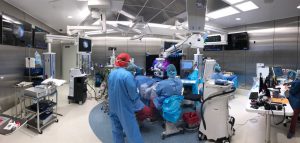What goes into a project? There are short term and long-term projects and some that require significant and ongoing research to understand how to initially start and develop a plan for a transformational and evolutionary shift. An example of a long-term project is the new David H. Koch Center (DHK) at Weill Cornell, New York-Presbyterian in New York, New York. Dr. Szilard Kiss, Associate Professor of Ophthalmology, Chief of the Retina Service and Director of Clinical Research, Tele-Ophthalmology and Compliance, said, “DHK was a decade in the making. Extensive research was conducted to completely understand our patients and their experience at Weill Cornell and Senior Vice President, Dr. Peter M. Fleischut, was one of the key transformation agents for this enormous undertaking.”
DHK’s extensive research uncovered the following patient and family perspectives about going to the hospital or Ambulatory Surgery Center (ASC):
- Uncertainty on where to go.
- Patients do not want to see their HCP, Healthcare Provider, in the cafeteria.
- Where will the family member be coming out after surgery?
- Surgeon and family interactions were clumsy in the waiting area.
- The patient and family asked directions five times before they arrived in the proper location which caused significant anxiety.
- HCP’s need a place to relax and an opportunity to eat and talk to their colleagues privately.
RetinaLink (RL): What is the process when I arrive at DHK on the day of my surgery?
Szilard KISS, MD (SK): It’s a smooth and paperless process. When you arrive at the Ambulatory Surgery Center, you don’t stop since Security knows who you are because of your RFID wristband. According to Dr. Kiss, “PATIENT EXPERIENCE is paramount.” Patients can register one week in advance. Their RFID wristbands with state-of-the-art technology can be mailed to their residence or they can pick them up upon arrival. We have an APP for New York-Presbyterian. The APP provides directions throughout the DHK facility. The DHK medical personnel and staff know where the patient is at all times. We have patient ambassadors equipped with earphones in the hallways. They know about that particular patient and where they need to go before they even ask their question.
RL: Outline the cornerstones of the DHK Project.
SK: The number one cornerstone is the PATIENT EXPERIENCE. Another cornerstone is our technology. Our surgical equipment is cutting edge and the “best of the best.”

Weill Cornell – DHK Operating Suite
DHK embodies a patient centric approach in all aspects of their medical care. The medical team FOCUS on point of care… paperwork is completed with the Physician Assistant (PA) so signing, confirming and ensuring everything is in order takes the burden off the HCP, nursing staff and technicians so they can focus on the surgical procedure. Electronic Medical Records are a must so secure WiFi is throughout DHK.
RL: What Intellectual Property (IP) came from the DHK Project?
SK: Our IP includes three items. One, the patient’s RFID wristband. Secondly, transmitter to track patients throughout DHK and three, NYP, New York-Presbyterian’s App for patients, HCP’s, medical personnel and families to communicate throughout their stay.
RL: How did other areas of medicine change their approach with the evolution of DHK?
SK: Oncology now focuses on mind and body in addition to the normal treatment. A more holistic approach with meditation and yoga. Another advance was moving Oncology from the basement. There are windows which provide natural light for patients and family members to see the outside world.
RL: How was the clumsy interaction with HCP’s and patients’ families rectified?
SK: A patient’s family has an assigned waiting area. This ensures the HCP and family don’t miss each other which was another anxiety trigger. For example, Mrs. Smith’s family is on the 6thFloor in Room 101. They are assigned to that room and DHK personnel know where to locate them.
RL: Are there future plans for DHK or are all phases of the project complete?
SK: The future is certainly bright at DHK. By 2020, the top two floors will house the NICU and birthing unit. The evolution continues.
Dr. Kiss can be reached via e-mail – [email protected]

